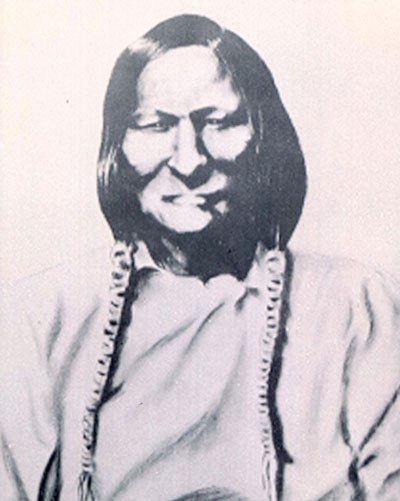
Drawing courtesy of the Oklahoma Historical Society Black Kettle belongs to the warrior society, the Elk Horn Scrapers. Scouting with fellow warriors, he located a Kiowa village along Wolf Creek in 1838. There, he gained prominence as a warrior during the great battle against the Kiowa, Comanche, and Apaches. He was present at the Treaty of Horse Creek (Fort Laramie) in September 1851, but not a signer. In 1853, he carried the Sacred Arrows against the Pawnees. The Sacred Arrows hold spiritual power that could be tapped ceremonially to help the tribe prosper. As long as the ceremonies were performed as taught by Sweet Medicine, the spiritual leader of the Cheyenne, the tribe would be protected. Failure to respect the bundles would be followed by misfortune to the tribe. Black Kettle led the first Cheyenne raiding party into Old Mexico, and once again carried the sacred arrows into battle. This time against the Delaware. In the winter of 1854, his father-in-law, Chief Bear Feathers, died and made Black Kettle chief of the Wutapiu band of Cheyenne. In 1854, Black Kettle was chosen to be a member of the Council of Forty-Four, a prestigious group of chiefs who were entrusted to lead their people with wisdom. In 1856, Black Kettle led a successful small war party to recover horses stolen by the Pawnee. On July 29, 1857, he participated at the Battle of Solomon’s Fork against Colonel Edwin Sumner’s 1st US Cavalry. By the early 1860s, however, this proven warrior had become an advocate of peace between his people and the white settlers. He was known to have signed such treaties as the Treaty at Fort Wise (1861), the Little Arkansas Treaty (1865), and the Medicine Lodge Treaty (1867). In September 1861, the commissioner of Indian Affairs, A.B. Greenwood, at Fort Wise, Colorado, gave a 34 star flag to Chief Black Kettle saying, "anyone will know you are a friend to the United States." Despite his efforts in keeping the peace on November 29, 1864, Black Kettle’s village on the Sand Creek was attacked. 150-200 Cheyenne men, women and children are murder, known as the Sand Creek Massacre by 3rd Colorado Volunteer Cavalry under Colonel John Chivington. Black Kettle rescued his wife, Medicine Woman Later, who had been shot nine times, from the Sand Creek camp by carrying her on his back. Four years later, in 1868, Black Kettle would be present for another attack on a Cheyenne village, this time in Oklahoma Territory along a river named the Washita. The night before the Washita attack, Black Kettle returned to his village after a 100-mile trip to Fort Cobb, where he and Arapaho Chief Big Mouth unsuccessfully petitioned the post commander, Colonel William B. Hazen, to have his village moved closer to the fort. Still confident of their safety, he resisted the entreaties of some of his people, including his wife, Medicine Women Later (Ar-no-ho-wok), to move their camp closer to the larger Cheyenne, Arapaho, and Kiowa encampments downriver. As a result, Chief Black Kettle and his wife were shot and killed by soldiers while crossing the Washita River, attempting to escape to the villages downstream. He also lost his other wife, Sioux Woman, during the fight. After Washita, Chief Black Kettle’s 'Wu-ta-pi-u' Band ceased to exist. Bibliography Grinnell, George Bird. The Fighting Cheyenne. Norman: University of Oklahoma Press, 1955. (pgs. 133, 146, 158, 167, 170-176, 188, 202, 245, 254, 270, 299, 305) Hardorff, Richard. Washita Memories: Eyewitness Views of Custer's Attack on Black Kettle's Village. Norman: University of Oklahoma Press, 2008. (pgs. 54-57, 427-431) Hatch, Tom. Black Kettle: the Cheyenne chief who sought peace but found war. Hoboken: John Wiley and Sons, Inc., 2004. (pgs. 21-23, 80-82, 146-166, 229-231, 239-242, 245-254) 
|
Last updated: September 11, 2021
